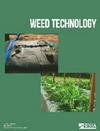俄克拉荷马州纯谷物冬小麦中的切特(Bromus secalinus L.)和唐氏锦鸡儿(Bromus tectorum L.)的综合管理
IF 1.3
3区 农林科学
Q3 AGRONOMY
引用次数: 0
摘要
在俄克拉荷马州,绒毛锦鸡儿和弊病是难以控制的冬季一年生牧草。过去,在俄克拉荷马州收获的冬小麦中,大部分面积都受到弊草的侵扰。对乙酰乳酸合成酶抑制性除草剂具有交叉抗性的生物类型使种植者在常规和耐除草剂系统中的管理选择极少。2019-20年和2020-21年在俄克拉荷马州拉霍马进行的田间试验评估了使用三种策略综合管理弊草和绒毛穗轴草的情况:种植日期(最佳、中期和晚期)、栽培品种选择(高竞争力和低竞争力)以及除草剂选择(不使用除草剂、35.2 g ai ha-1的磺酰磺隆和18.4 g ai ha-1的吡唑醚菌酯)。收集了视觉控制、出现的杂草种类(属)、小麦拔节期生物量和谷物产量数据。2019-20 年,处理后 8 至 9 周,与最佳播种期相比,播种中期的视觉控制率提高了 15%,播种晚期与播种中期相比提高了 14%。在 2020-21 年,中耕和晚耕的控制率相似(∼99%),比最佳播种期的控制率高 23%。由于杂草覆盖率不高,2019-20 年的杂草生物量对种植日期、栽培品种或除草剂处理没有反应。2020-21 年期间,中晚期种植的绒毛褐飞虱生物量比最佳种植期低 90%。同年,施用除草剂后,绒毛丛草和螯合草的生物量较低(≤ 0.4 和 0.2 g m-2),比未施用除草剂时减少 98%。与2019-20年度的中后期种植相比,最佳种植期的小麦籽粒产量最高。从最佳播种期推迟到中期或晚期播种,小麦产量分别减少了 14% 和 21%。2020-21 年,晚播比最佳播种期小麦减产 57%。推迟播种日期和使用普通除草剂可抑制弊病和绒毛枯萎病,但小麦产量可能会下降。本文章由计算机程序翻译,如有差异,请以英文原文为准。
Integrated Management of Cheat (Bromus secalinus L.) and Downy Brome (Bromus tectorum L.) in Oklahoma Grain Only Winter Wheat
In Oklahoma, downy brome and cheat are difficult-to-control winter annual grasses. In the past, cheat infested most of the winter wheat hectares harvested in Oklahoma. Biotypes cross-resistant to acetolactate-synthase-inhibiting herbicides have left growers with minimal management options in conventional and herbicide-tolerant systems. Field trials at Lahoma, Oklahoma in 2019-20 and 2020-21 evaluated integrated management of cheat and downy brome using three strategies: planting date (optimal, mid-, and late), cultivar selection (high- and low-competitiveness), and herbicide choice (no herbicide, sulfosulfuron at 35.2 g ai ha-1 and pyroxsulam at 18.4 g ai ha-1). Visual control, weed species (spp.) present, wheat biomass at heading, and grain yield data were collected. In 2019-20, eight to nine weeks after treatment, visual control increased 15% with mid-planting compared to optimal planting date and 14% with late planting compared to mid-planting. In 2020-21, similar control (∼99%) was recorded for mid- and late plantings with 23% greater control than the optimal timing. Due to a lack of weed coverage, weed biomass in 2019-20 had no response to planting date, cultivar, or herbicide treatment. Downy brome biomass during 2020-21 was ∼90% lower with mid to late planting than optimal. In the same year, downy brome and cheat biomass were low (≤ 0.4 and 0.2 g m-2) and 98% less after an herbicide application than nontreated. Wheat grain yield at the optimal planting date was greatest compared to mid- and late planting date for 2019-20. A delay in planting from the optimal date to mid- or late timings decreased wheat yield 14 and 21%, respectively. In 2020-21, late planting reduced wheat yield 57% compared to optimal planting. Delaying planting date and the use of a common herbicide can suppress cheat and downy brome., but a decline in wheat yield may occur.
求助全文
通过发布文献求助,成功后即可免费获取论文全文。
去求助
来源期刊

Weed Technology
农林科学-农艺学
CiteScore
2.90
自引率
21.40%
发文量
89
审稿时长
12-24 weeks
期刊介绍:
Weed Technology publishes original research and scholarship in the form of peer-reviewed articles focused on understanding how weeds are managed.
The journal focuses on:
- Applied aspects concerning the management of weeds in agricultural systems
- Herbicides used to manage undesired vegetation, weed biology and control
- Weed/crop management systems
- Reports of new weed problems
-New technologies for weed management and special articles emphasizing technology transfer to improve weed control
-Articles dealing with plant growth regulators and management of undesired plant growth may also be accepted, provided there is clear relevance to weed science technology, e.g., turfgrass or woody plant management along rights-of-way, vegetation management in forest, aquatic, or other non-crop situations.
-Surveys, education, and extension topics related to weeds will also be considered
 求助内容:
求助内容: 应助结果提醒方式:
应助结果提醒方式:


